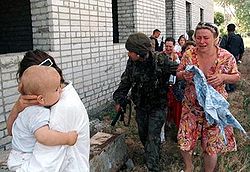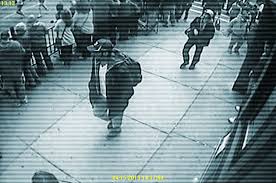Over the last two decades, we have analyzed terrorist groups and the potential for likely future attacks-and target strategy based on the tactics which seemed to achieve the desired outcome. Chechen Separatists tactics “ran the table†on known cruel and bloodthirsty approaches to promote their cause.
In their long and costly wars with Russia and its subsequent governing bodies, they found few successes over their more powerful enemy. Deadly attacks on soft targets of all types failed to bring their more powerful Russian enemy to the negotiating table. A patchwork of aggressive terrorist attacks resulted in crushing retaliatory actions which resulted in costly civilian deaths and material destruction; the 2002 Moscow Theater Hostage Crisis, bombings across the country targeting populated apartment buildings, airports, other transportation – mainly rail – and the planting of radioactive devices did little to advance their cause.
 The protracted horror and anguish associated with the ghastly Beslan school hostage event shocked and outraged the world and made few friends. Months before the attack separatist groups had infiltrated the village disguised as laborers working to improve one of its schools. The group took 1,100 hostages including 777 children, many held inside of their school. Â Three days of heated negotiations with the Russian Government over Chechen demands to become an independent country broke-down and the slaughter began, resulting in the death of 334 hostages including 186 children. The most horrific scenes were of children being cut down trying to escape from their makeshift schoolhouse-prison. The only event that did manage to change the course of the bitter long first war was the Budyonnovsk hospital hostage crisis in June of 1995, which resulted in a ceasefire and favorable political terms but fell short of Independence. Â Â A group of separatists attempted to capture the town of Budyonnovsk (60,000).
The protracted horror and anguish associated with the ghastly Beslan school hostage event shocked and outraged the world and made few friends. Months before the attack separatist groups had infiltrated the village disguised as laborers working to improve one of its schools. The group took 1,100 hostages including 777 children, many held inside of their school. Â Three days of heated negotiations with the Russian Government over Chechen demands to become an independent country broke-down and the slaughter began, resulting in the death of 334 hostages including 186 children. The most horrific scenes were of children being cut down trying to escape from their makeshift schoolhouse-prison. The only event that did manage to change the course of the bitter long first war was the Budyonnovsk hospital hostage crisis in June of 1995, which resulted in a ceasefire and favorable political terms but fell short of Independence. Â Â A group of separatists attempted to capture the town of Budyonnovsk (60,000).
 They met unexpected heavy Russian resistance, were forced to retreat and during their retreat, they took 2000 citizen hostages and made their stand in the City’s Hospital. The separatists sent their demands to the Russian Government (Yeltsin) and on the 15th of June the first hostage was killed. When the demand for Russian reporters failed to materialize, 5 randomly selected hostages were killed. Three Russian assaults failed to penetrate the hospital and the government agreed to meet some short term demands.. In the meantime an estimated 166 hostages were killed and 541 were wounded. . It did not bring the separatists independence but did bring their adversaries to the negotiating table and was seen as a temporary victory for the Chechens.
They met unexpected heavy Russian resistance, were forced to retreat and during their retreat, they took 2000 citizen hostages and made their stand in the City’s Hospital. The separatists sent their demands to the Russian Government (Yeltsin) and on the 15th of June the first hostage was killed. When the demand for Russian reporters failed to materialize, 5 randomly selected hostages were killed. Three Russian assaults failed to penetrate the hospital and the government agreed to meet some short term demands.. In the meantime an estimated 166 hostages were killed and 541 were wounded. . It did not bring the separatists independence but did bring their adversaries to the negotiating table and was seen as a temporary victory for the Chechens.
Worldwide examples of the vulnerability of Hospitals to any manner of terrorist’s attacks are well documented. Some have been simply brazen attacks of terrorists walking into hospitals and killing patients. Truck and car bombs have been hugely effective. Some terrorists have resorted to suicide bombers masquerading as patients, while others have been targets of opportunity killed while being transferred from ambulance to Emergency entrance. One-fifth of the Mumbai terrorist force attacked the city’s CAMA Hospital, demonstrating what a few terrorists with assault rifles can do simply walking through the front door and opening fire at random targets. CAMA was the third such attack on the region’s hospitals.
We are not surprised that the alleged Boston Marathon bombers with Chechen backgrounds chose the sporting event as a target. The fact that they did not act as “martyrs†in the first attack (Marathon bombing) and the large stockpile of other IEDs makes us suspect that they had several other targets in mind following the initial attack. And what better option than a hospital, such as what had been the most successful of previous Chechen terrorist events?   If the other half of the plan was to attack the hospital with the greatest number victims, it would have resulted in a Terror Multiplier Effect (TME).
 The shock and anxiety over killing spectators at one of the world most celebrated Marathon events is the stuff that gives “all those associated with like events†sleepless nights.  Hurricane Alerts strike fear in the hearts of those along the Atlantic and Gulf Coasts, and elicit empathy from the folks in the Mid-West. The risk of bringing down a major hospital’s ability to provide mass-casualty care in the wake of an event like this bombing has not yet been experienced here in the US, but as long as hospitals continue to be seen as the “weakest link in the Homeland Security Chainâ€, this TME threat looms large and will eventually be exploited here as it has in other countries.
The shock and anxiety over killing spectators at one of the world most celebrated Marathon events is the stuff that gives “all those associated with like events†sleepless nights.  Hurricane Alerts strike fear in the hearts of those along the Atlantic and Gulf Coasts, and elicit empathy from the folks in the Mid-West. The risk of bringing down a major hospital’s ability to provide mass-casualty care in the wake of an event like this bombing has not yet been experienced here in the US, but as long as hospitals continue to be seen as the “weakest link in the Homeland Security Chainâ€, this TME threat looms large and will eventually be exploited here as it has in other countries.





0 Comments